25 Feb 2013
There’s a good reason for taking a trip up the Hume Highway. From March, there will be an exclusive collection of Japanese prints on exhibition at the Shepparton Art Museum (SAM).
It’s a showing, the only in Australia, of world renowned wood block prints and paintings (Ukiyo-e) by three of the most famous artists in Japanese history – Torii Kiyonaga, Kitagawa Utamaro and Toshusai Sharaku, along with a selection of work by their contemporaries.
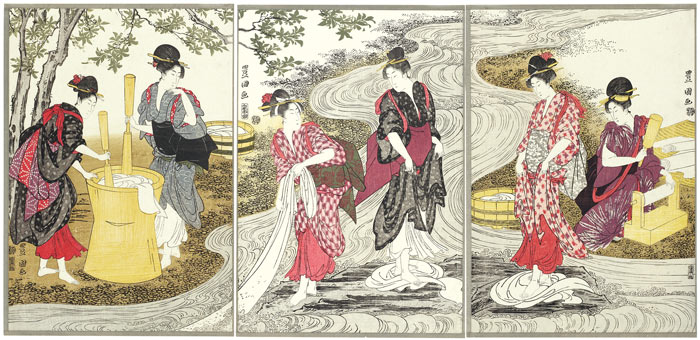
The Chōfu Jewel River (Chōfu no Tamagawa)
Utagawa Toyokuni I (Japanese, 1769–1825)
Publisher: Izumiya Ichibei (Kansendō) (Japanese)
Japanese, Edo period, about 1795–1801 (late Kansei era)
Woodblock print (nishiki e); ink and color on paper
Vertical ōban, right sheet of triptych; 36.1 x 25.0 cm (14 3/16 x 9 13/16 in.)
William Sturgis Bigelow Collection 11.24991
Image courtesy © Museum Fine Arts, Boston
And if that’s not enough to get you there, the events coinciding with the exhibition – a Japanese dinner informed by Tokyo at the time of Ukiyo; a Mother’s Day, Japanese infused high tea; a wood print workshop; and a variety of talks by artists and art experts – just might have you planning to visit the Goulburn Valley.
The Greater Shepparton Mayor, Jenny Houlihan knows the significance to the regional town,
“… Large-scale exhibitions of Japanese art are rarely staged by Australian galleries …”
The exhibition is drawn from the collection of the Museum of Fine Arts in Boston, one of the most significant collections of Japanese prints in the world. It was a trip by Shepparton Art Museum’s director, Kirsten Paisley, to Shepparton’s sister Japanese city that led to the coup for the art museum and town.
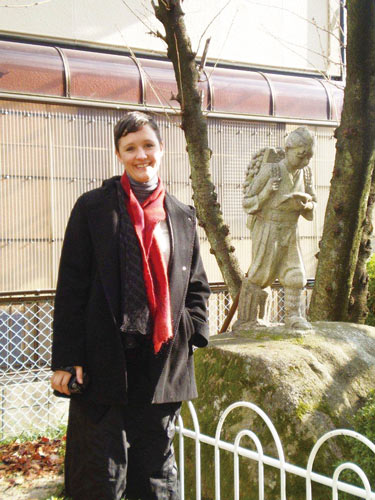
Shepparton Art Museum’s director, Kirsten Paisley
“It’s huge … the works provide a window into a culture on the cusp of a significant change. It’s the moment just before Japan opened up to the rest of the world,” she says.
Kirsten rightly feels proud. The large collection of one hundred pieces has been seen only in Japan, the USA and now, Australia.
Ukiyo, the floating world
The term, ‘floating world’, Ukiyo, was a Buddhist reference to the human condition: searching for happiness in material objects and experiences. It was later used to describe a sub-culture of urban life – living carefree surrounded by pleasures found in cities of the day: fashion, sport, theatre, sensual pleasure and enjoyment in the outdoors.
Don’t be surprised if it sounds familiar; comparisons to our twenty-first century contemporary society are easily made. The merchant class had prospered during the Edo period, there were no wars; it was a time to enjoy life. Cashed-up consumers wanted entertainment, art and beauty. Today’s preoccupation with movie stars, sport and fashion could be compared with an eighteenth century Japanese fascination with kabuki actors, sumo, and sensual pleasures (geishas and courtesans).
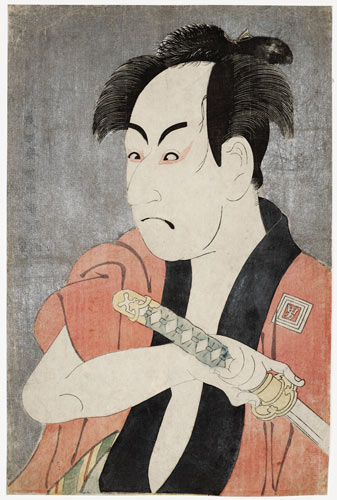
Actor Ichikawa Omezō as the Manservant Ippei
Tōshūsai Sharaku (Japanese, active 1794 – 1795)
Publisher: Tsutaya Jūzaburō (Kōshodō) (Japanese)
Japanese, Edo period, 1794 (Kansei 6), 5th month
Woodblock print (nichiki-e): ink, colour and mica on paper
William Sturgis Bigelow Collection, 11.14672
Image courtesy © Museum Fine Arts, Boston
Wood block printing: a triumph of commercial innovation
A family might want to decorate their home with a print of a Buddhist talisman or image of their favourite kabuki actor. “A piece could be bought for what would be equivalent today of the price of a meal out,” says Wayne Crothers, Japanese art expert and Curator at the National Gallery of Victoria, describing how the woodblock printing process enabled enterprising publishers to satisfy the burgeoning cultural appetite of a freewheeling middle-class.
Publishers and printers refined their techniques to satisfy a mainstream indulgence, and this commercial innovation has left us with what Wayne describes as ‘the most visually exciting, technically intricate, economically affordable and popular art forms the world has seen’.
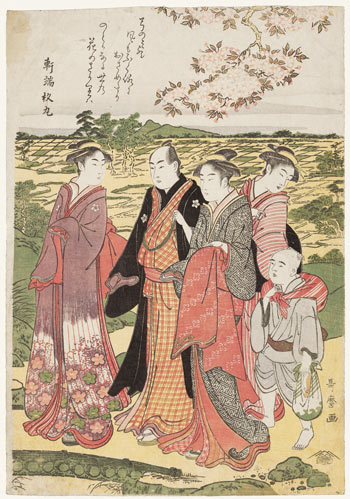
A Spring Outing
Kitagawa Utamaro I (Japanese, (?)- 1806)
Publisher: Tsutaya Jūzaburō (Kōshodō) (Japanese)
Japanese, Edo period, about 1787–88 (Tenmei 7–8)
Woodblock print (nishiki e); ink and color on paper
Vertical ōban; 37.5 x 26 cm (14 3/4 x 10 1/4 in.)
William Sturgis Bigelow Collection 11.14402
Image courtesy © Museum Fine Arts, Boston
The life of a Japanese master
The three Japanese masters featured in the exhibition are the most famous artists of this historically important art form. Having trained their entire lives, they were typical of pioneers of any radical art movement, immersed in the object of their creative expression – the floating world.
Kitagawa Utamaro (1753 – 1806) – for instance, lived close to the pleasure quarters, the home of geisha and courtesans; his work is said to reveal the personality and character of his subjects. The woman in the iconic artwork, Okita, the Naniwaya Tea-shop waitress, would have been well known to him. Utamaro is credited with providing the most skillful and elegant expressions of feminine beauty, bijinga, in the history of Japanese art, a consequence of his closeness to the individuals that have been immortalized in print.
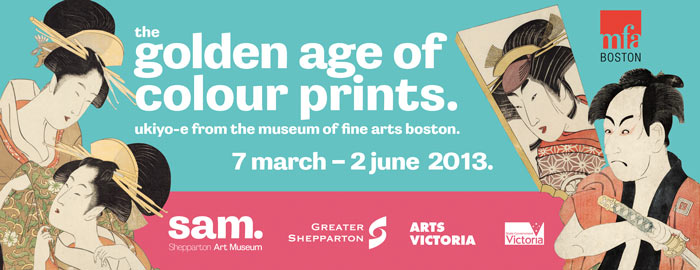
The array of exotic Japanese artwork provides a mirror to our times. It is an exhibition of importance not to be missed, making the trip to Shepparton well worth it. The Golden Age of Colour Prints opens Thursday, March 7 to coincide with the SheppARTon Festival and continues until Sunday, June 2.
Tickets are available on-line from Shepparton Art Museum’s website.

Shepparton Art Museum (SAM)
70 Welsford St Shepparton 3630
mail: Locked Bag 1000, Shepparton, VIC, Australia 3630
phone: +61 (03) 5832 9861 f +61 (03) 5831 8480
http://www.sheppartonartmuseum.com.au
Open 7 days, 10.00am to 4.00pm
Public holidays 1.00pm to 4.00pm
SAM is open every day except Christmas day, New Years day and Good Friday.
Article: Peter Dewar




